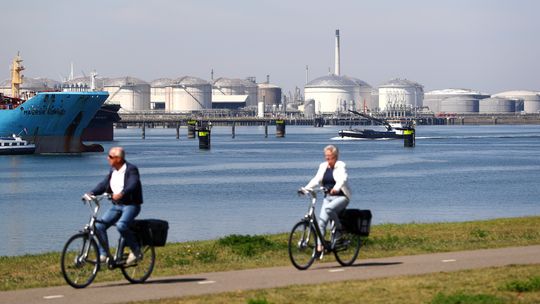Natural-gas futures climb over 7% for the week
Oil futures ended lower on Friday, on the back of a smaller-than-expected gains in U.S. nonfarm payrolls in August, but a slow post-hurricane recovery in energy operations at the Gulf of Mexico contributed to a gain in prices for the week.
Data released Friday showed U.S. nonfarm payrolls rose by 235,000 jobs in August, well below the 720,000 increase expected by economists surveyed by The Wall Street Journal.
“U.S. hiring slowdown could be a short-term drag for the demand outlook” on oil, said Edward Moya, senior market analyst at Oanda, in a market update.
Investors also assessed the U.S. Gulf Coast, where the aftermath of Hurricane Ida last weekend has left a swath of destruction and oil refineries in Louisiana shut in. Remnants of the storm also buffeted the U.S.’s Northeast on Thursday, leaving at least 45 people dead.
“It appears that the damage caused by Hurricane Ida is presenting greater challenges than any Gulf storm we’ve seen, perhaps since Harvey or Katrina, because of the damage it’s done to Port Fourchon, Louisiana, a major staging area for operations in the Gulf of Mexico,” said Phil Flynn, senior market analyst at The Price Futures Group.
The Bureau of Safety and Environmental Enforcement reported Friday that 93.33% of Gulf oil production and 89.25% of natural-gas production have been shut-in. That shows little improvement from shut ins of 93.55% for oil and 91.29% for natural gas on Thursday.
Production is “coming back more slowly,” said Flynn, in a daily report.
On Friday, Baker Hughes BKR, -0.81% on Friday reported the largest weekly drop in U.S. oil-drilling rigs so far this year, following evacuations in the Gulf of Mexico due to the hurricane last weekend. The number of active U.S. rigs drilling for oil dropped by 16 at 494 this week.
The rig count is likely to continue to decline next week, Flynn told MarketWatch. “It’s going to take some time for producers in the Gulf of Mexico to come back online,” he said.
West Texas Intermediate crude for October delivery CLV21, -0.27% CL.1, -0.27% on the New York Mercantile Exchange lost 70 cents, or 1%, to settle at $69.29 a barrel. It closed up 2% on Thursday and logged the highest front-month contract settlement since Aug. 3, according to Dow Jones Market Data.
Prices for the U.S. benchmark finished 0.8% higher for the week, according to Dow Jones Market Data.
Global benchmark November Brent crude BRNX21 declined by 42 cents, or 0.6%, to $72.61 a barrel on ICE Futures Europe, marking a weekly rise of 1.3%.
Oil futures this week were supported by data that showing a sharp drop in U.S. crude inventories for the week ended Aug. 27, even as OPEC and its allies decided Wednesday to stick to a plan to increase oil production by 400,000 barrels a day each month from August.
The EIA also reported an unexpected increase in last week’s domestic gasoline stockpiles, ahead of Labor Day holiday weekend travel, which usually boosts demand for the fuel.
On Nymex Friday, October gasoline RBV21, -0.40% shed 0.4% to $2.15 a gallon, ending 1.6% higher for the week. October heating oil HOV21, -0.34% edged down by 0.4% to settle at $2.16 a gallon, but up 2.5% for the week.
October natural gas NGV21, -0.32% stretched its streak of gains to a fourth straight session, up 1.5% at $4.71 per million British thermal units, with front-month prices holding ground at their highest since November 2018. For the week, they settled up by 7.4%.
Natural-gas prices climbed on Thursday after the Energy Information Administration reported a weekly rise of 20 billion cubic feet in supplies of the fuel in storage. Supplies remain below the year-ago and five-year average levels.
“Offshore natural gas production remains nearly entirely offline, with a full return of production currently not in sight” following Hurricane Ida, said Christin Redmond, global commodity analyst at Schneider Electric, in a daily report.
“While most Louisiana ports have reopened to vessel traffic as of [Thursday], damage to roads and power and water services infrastructure around Port Fourchon have made it unlikely that offshore production will ramp up quickly,” she said.

